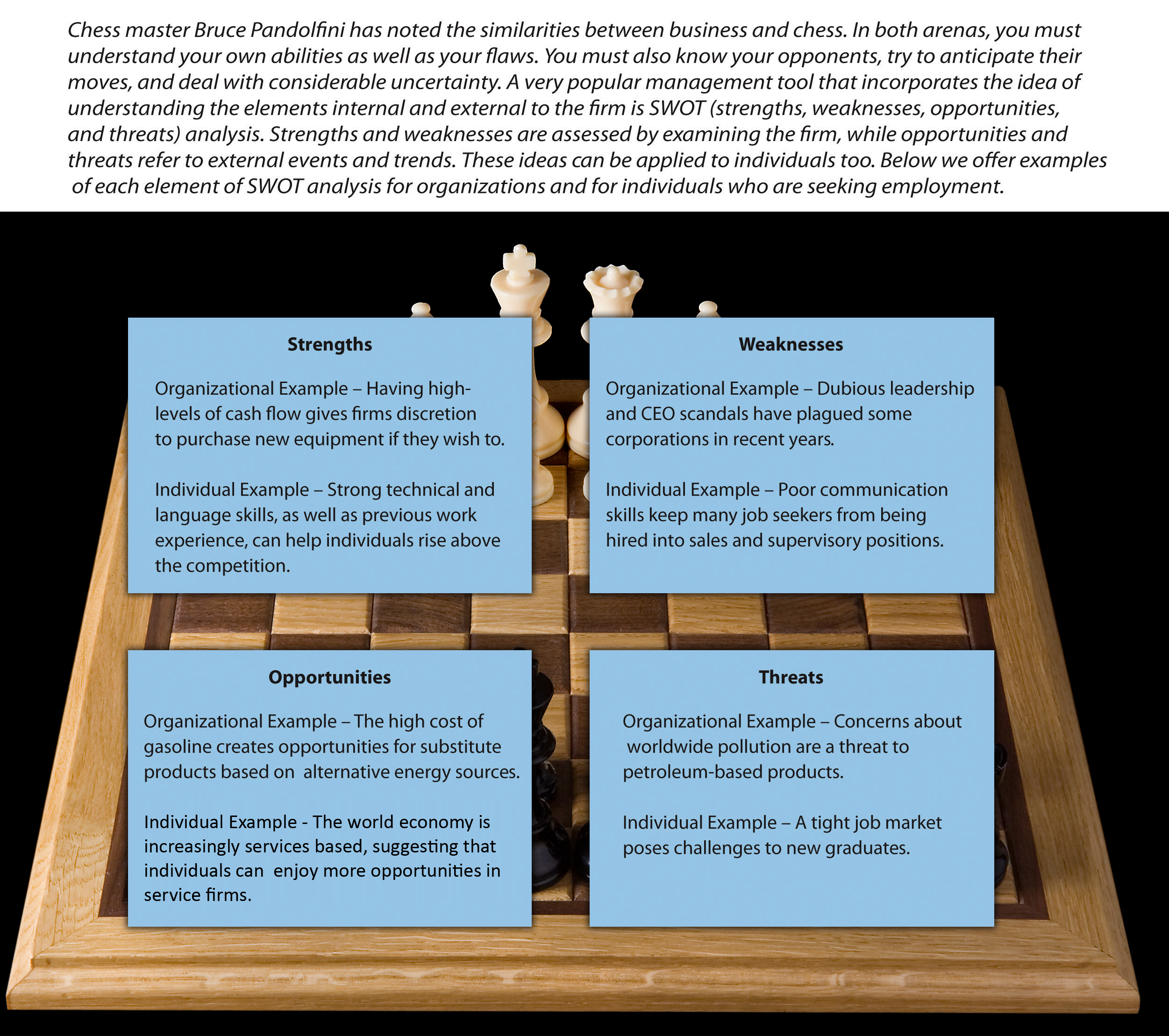5.5 SWOT Analysis
After reading this section, students should be able to …
- Understand what SWOT analysis is.
- Learn how SWOT analysis can help organizations and individuals, and its limitations.
The SWOT analysis is a tool that considers a firm’s strengths and weaknesses along with the opportunities and threats that exist in the firm’s environment (Figure 5.3 “SWOT”).

Executives use the OT part of the SWOT analysis to identify the external factors in the competitor environment. In general, it helps capitalize on opportunities, and protect itself against external threats. For example, untapped overseas market opportunities have presented potentially lucrative market opportunities to Subway. Meanwhile, Subway’s strengths include a well-established brand name and a simple business format that can easily be adapted to other cultures. In considering the opportunities offered by overseas markets and Subway’s strengths, it is not surprising that entering and expanding in different countries has been a key element of Subway’s strategy in recent years. Indeed, Subway currently has operations in over 100 nations. Of course, other restaurant chains such as McDonald’s and KFC also see this overseas opportunity, and are external threats to Subway’s success (Wikipedia, 2014).
The opportunities and threats refer to the external environment outside the company. It is important not to list strengths as opportunities, for example, if executives are to succeed at matching internal and external concerns during the idea generation process.
Opportunities should not be confused with strategic moves designed to capitalize on these opportunities. In the case of Subway, it would be a mistake to list “entering new countries” as an opportunity. Instead, untapped markets are the opportunity presented to Subway, and entering those markets is a way for Subway to exploit the opportunity. Finally, and perhaps most important, the results of SWOT analysis should not be overemphasized. SWOT analysis is a relatively simple tool for understanding a firm’s situation, which is inherently complex. As a result, SWOT is best viewed as a brainstorming technique for generating creative ideas, not as a rigorous method for selecting strategies. Thus, the ideas produced by SWOT analysis offer a starting point for executives’ efforts to craft strategies for their organization, not an ending point.
In addition to organizations, individuals can benefit from applying SWOT analysis to their personal situation. A college student who is approaching graduation, for example, could lay out his or her main strengths and weaknesses and the opportunities and threats presented by the environment. Suppose, for instance, that this person enjoys and is good at helping others (a strength) but also has a rather short attention span (a weakness). Meanwhile, opportunities to work at a rehabilitation centre or to pursue an advanced degree are available. Our hypothetical student might be wise to pursue a job at the rehabilitation centre (where her strength at helping others would be a powerful asset) rather than entering graduate school (where a lot of reading is required and her short attention span could undermine her studies).
Key Takeaways
- Executives using SWOT analysis compare internal strengths and weaknesses with external opportunities and threats to generate ideas about how their firm might become more successful. Ideas that allow a firm to leverage its strengths, steer clear of or resolve its weaknesses, capitalize on opportunities, and protect itself against threats are particularly helpful.
Exercises
- What do each of the letters in SWOT represent?
- What are your key strengths, and how might you build your own personal strategies for success around them?
References:
Wikipedia. (2014). Subway (Restaurant). Retrieved from http://en.wikipedia.org/wiki/Subway_(restaurant)
Sources:
Section 5.5 SWOT Analysis is edited and adapted from the chapter ‘SWOT Analysis’ in the textbook, ‘Mastering Strategic Management – 1st Canadian Edition’ by Janice Edwards, Centennial College, Dave Ketchen, Auburn University, and Jeremy Short, University of Oklahoma, Copyright Year: 2014.

Image descriptions
Figure 5.3 image description: SWOT
Chess master Bruce Pandolfini has noted the similarities between business and chess. In both arenas, you must understand your own abilities as well as your flaws. You must also know your opponents, try to anticipate their moves, and deal with considerable uncertainty. A very popular management tool that incorporates the idea of understanding the elements internal and external to the firm is SWOT (strengths, weakness, opportunities, and threats) analysis. Strengths and weaknesses are assessed by examining the firm, while opportunities and threats refer to external events and trends. These ideas can be applied to individuals too. Below we offer examples of each element of SWOT analysis for organizations and for individuals who are seeking employment.
- Strengths
- Organizational Example – Having high-levels of cash flow gives firms discretion to purchase new equipment if they wish to.
- Individual Example – Strong technical and language skills, as well as previous work
experience, can help individuals rise above the competition.
- Opportunities
- Organizational Example -The high cost of gasoline creates opportunities for substitute products based on alternative energy sources.
- Individual Example – The world economy is increasingly service based, suggesting that individuals can enjoy more opportunities in service firms.
- Weakness
- Organizational Example — Dubious leadership and CEO scandals have plagued some corporations in recent years.
- Individual Example – Poor communication skills keep many job seekers from being hired into sales and supervisory positions.
- Threats
- Organizational Example — Concerns about worldwide pollution are a threat to
petroleum-based products. - Individual Example – A tight job market poses challenges to new graduates.
- Organizational Example — Concerns about worldwide pollution are a threat to

